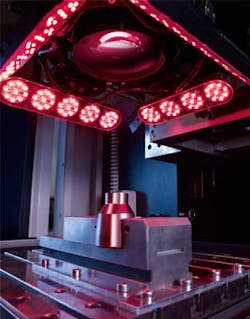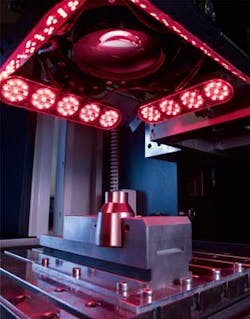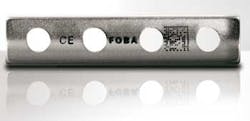Laser marking in the medical technology industries
Dana Francksen
It’s all about high precision, efficiency and zero defects
The medical industry has utilized laser technology to mark medical devices for many years. The reliability and the indelible mark that lasers produce have been a great asset to many of these companies. Laser marking and engraving still have the potential to improve and help the medical industry with quality control and product throughput.
Writing a report about these demanding applications can be compared to looking into the kitchen while at the same time starving: It smells appetizing, but as soon as you approach the pots, you get a rap on your knuckles. The appeal remains, and is even enhanced, but the basic need is unsatisfied. Nearly the same is true for laser material processing applications in the medical industry: There are many exciting applications and fascinating innovations, but instead of covering detailed information and presenting exemplary images, non-disclosure agreements prevent poking one’s nose deeper into the pots. Despite this challenge, this article tries to outline both state-of-the-art processes and innovative developments.
Classical applications
Until recently, laser marking in the medical industry meant the classical applications like marking of stainless steel surgical and dental instruments with easily readable marks that have to resist even centuple sterilizations. Most of all, it is all about marking with absolutely plain surfaces that prevent germs from sticking on the surface. The marked surface must not damage the chemical passivation that is needed for corrosion resistance so that the anticorrosive coating remains – even after years of usage and infinite cleanings and sterilizations.
“Numerous experiments and tests – both in our labs and external labs – supported our application development department in coming to solutions that today exactly meet these strict requirements,” says Ulrich Ofer, VP for marketing and applications for FOBA (www.foba.de). “What works for surgical instruments also works for implants such as bone plates, bone screws, hips, and artificial joints. Other processible materials, apart from stainless steel, are titanium, silver, or ceramics. In general, it is all a matter of defining the most suitable laser wavelength and special laser parameters for the respective material.”
Documented applications
Laser marking in the medical industry has also become one of the preferred identification processes as it ensures high-quality marks, high precision, system reliability, and great repetition accuracy. Manufacturers in the medical sector are bound to strict adherence to defined processes. Possible changes to accepted marking templates must therefore be documented in detail. Manufacturers with equipment that is capable of repetition accuracy by the help of vision systems are on the inside track. Some suppliers already offer marking machines with integrated vision that are capable of detecting changed component positions and defective or flawed parts and automatically aligning the marking relative to these. By doing this, it is no longer or only very seldom necessary that manufacturers adapt marking jobs and thus existing processes and documentations.
Quality assurance and traceability
To enable smooth, hygienic and long- lasting marks on most materials, a broad range of laser technologies, wavelengths, laser powers, and pulse widths to choose from is the prerequisite. Such uncompromising high quality marks have a further task to fulfill: They have to be qualified for both internal and external quality assurance and traceability tests. This is how individual 2D code marks on individually manufactured implants can be used for checking whether the one and only implant is available for implantation. All these code and traceability options are integrated in state-of-the-art laser marking software programs – from the marking of a part number as 2D code through the application of consecutive numberings as bar or 2D codes to applying logos or measuring marks of graphics.
Integrated vision for less waste and high-precision
If lasers are operated by printing a job without determining if the correct part is present, or, if there is even a part in position at all, then parts could be marked with incorrect information and/or marked in the incorrect location, creating waste parts. Since many of the medical devices manufactured are expensive, this waste has a significant impact on the bottom line.
Medical devices such as bone screws and hip replacement parts are made in various sizes but the basic shape can be the same. Incorrect mark content on a part can result in not only wasted parts, but also a potential quality control nightmare that can have severe legal ramifications.
Product waste and quality issues like these can now be reduced to a minimum. The use of an integrated vision system – for example, FOBA’s patented through-the-lens mark alignment system Intelligent Mark Positioning (IMP) – ensures that codes are marked not only on the correct parts but also on the correct position on the parts.
“IMP aligns a pattern to a part accurately and precisely, which results in no misaligned parts, no waste, precision tooling, no fixturing and machine to machine consistency,” says Brian Hilliker, sales manager for FOBA North America (www.fobalaser.com). “Such laser marked codes not only comfort patients but also health insurances. They have to assure that marks have no predetermined breaking points that could shorten the lifespan of implants or prostheses.” Integrated vision systems are now being used to help manufacturers machine parts faster, with less waste, quicker setup times and lower operational costs.
Manufacturers benefit from such uncompromising traceable quality: A lifetime lasting mark can be used against unwarranted claims for compensation, as each and every part can be completely traced and easily distinguished from copies of any kind. Optical control systems also allow for efficient manufacture even when it comes to high-quality work pieces and individual parts. With some vision control processes, marking contents are placed manually on the products to be marked, which makes these processes especially well-suited for the processing of high-quality work pieces and individual parts. Optical inspection for the validation of the final marking and checking of whether all information to be included has been marked is getting more and more important as it allows an advance verification of marking and marking position and thus helps to avoid expensive production stops and time-consuming trial-and-error processes.
Cold applications
Major developments and innovations in the laser marking of medical plastics have come up just recently. So called cold laser markings, enabled with UV laser markers, meet the requirements for strict hygiene for invasive applications. Absolutely plain surfaces are inevitable to hinder germs from sticking onto the material and to prevent material substances from finding their way into the body. UV laser markers work with minimum heat and only photo-chemically colorize the material surface instead of foaming it. Thus, these sensitive plastic materials are marked damage-free so that they are usable for invasive tasks.
Five years ago, such a solution was inconceivable. Today, these cold markers apply high precision, damage-free, and lasting marks on the most sensitive products and parts such as catheters or invasive devices such as insulin pumps that need to be sterilized. Also previously unmarkable materials such as silicones or polyamides can now be marked. The marking results such UV laser markers produce are down to the last detail: the 355nm wavelength enables extra fine and high contrasts. And finally, neither solvents nor material additives are required for marking these sensitive plastics.
“Processing the surface has basically to do with the creation of ideal conditions for bio reactions or biosensors, and with artificial cavities to build fluid reservoirs or specific scallop heights, to achieve defined flow rates for sufficient time slots at reactions,” says Ofer. Creating microstructures is widely spread in many technical areas and has now become popular within the medical and biochemical sectors. “Most of these new developments arise from the close collaboration with worldwide customers.”
Where do we go from here?
Laser marking plays an important role in the medical industry. Many manufacturers have discovered the laser’s versatility, accuracy, benefits, and cost savings in their operations. They can be used for sensitive applications, quality control, waste reduction, increasing production and enhancing accuracy. However, the demands put on the medical industry – whether it is due to documentation, new or sensitive materials, technology or other changes in the marketplace – requires laser marking manufacturers to continually improve and grow to keep up.
Laser marking manufacturers are looking at ways to offer machines and systems that are more automated and flexible, resulting in less part handling. Whether that is through vision, additional or more complex axis control and/or software, or through laser technology itself, one can be assured that the equipment will become more efficient, reduce costs and improve the quality of the marked parts.
By forming partnerships and truly understanding what is important to the industry, laser manufacturers will be more able to supply them with those key ingredients to make them more successful.
Dana Francksen([email protected]) is manager, marketing communications for FOBA Laser Marking + Engraving, Selmsdorf, Germany.
More Industrial Laser Solutions Current Issue Articles
More Industrial Laser Solutions Archives Issue Articles




